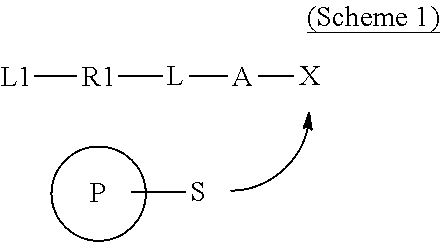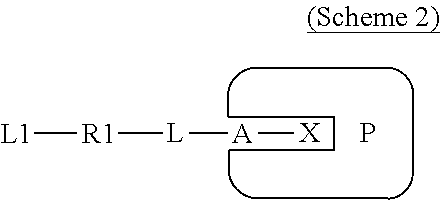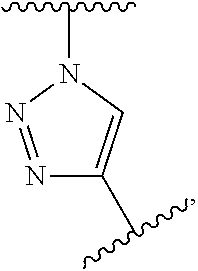Covalently binding imaging probes
a covalent binding and imaging probe technology, applied in the field of molecular probes, can solve the problems of imbalance, affecting the use of drugs, and imposing a considerable challeng
- Summary
- Abstract
- Description
- Claims
- Application Information
AI Technical Summary
Problems solved by technology
Method used
Image
Examples
example 1
Cathepsin S Probe
[0170]
[0171]The compound was prepared according to the procedure for Solid Phase Peptide Synthesis on Sieber resin, and purified by HPLC (H2O+0.05% TEA; 4-95% CH3CN). Calculated: [M+H]+=627.8, found: [M+H]+=627.2. Yield: 72%.
example 2
Cathepsin K Probe
[0172]
[0173]The compound was prepared according to the procedure for Solid Phase Peptide Synthesis on Sieber resin, and purified by HPLC (H2O+0.05°% TEA; 4-95% CH3CN). Calculated: [M+H]+=702.9, found: [M+H]+=702.3. Yield: 72%.
example 3
Caspase-1 Probe
[0174]
[0175]70.4 mg (0.3 mmol) of ((2R,3S)-2-Ethoxy-5-oxo-tetrahydro-furan-3-yl)-carbamic acid allyl ester (WO9903852) was dissolved in 5 ml DCM. 48 mg (0.3 mmol) 1,3-Dimethylbarbituric acid and 29.5 mg (0.0025 mmol) tetrakistriphenylphosphine Palladium (0) were added in portions. The solution turned red after a minute. After 1 h, 121 mg (0.25 mmol) of Building block (VI), 107 mg HATU, 38 mg HOAt and 80 μl DIPEA in 5 ml DCM were added. The reaction was stirred at room temperature for 12 h. The reaction mixture was washed with water, 0.5 M NaHSO4-solution and brine. The organic phase was concentrated and the product purified by silica gel column chromatography (DCM / MeOH) to yield 0.068 g. Calculated: [M+H]+=601.6, found: [M+H]+=602.
PUM
 Login to View More
Login to View More Abstract
Description
Claims
Application Information
 Login to View More
Login to View More - R&D
- Intellectual Property
- Life Sciences
- Materials
- Tech Scout
- Unparalleled Data Quality
- Higher Quality Content
- 60% Fewer Hallucinations
Browse by: Latest US Patents, China's latest patents, Technical Efficacy Thesaurus, Application Domain, Technology Topic, Popular Technical Reports.
© 2025 PatSnap. All rights reserved.Legal|Privacy policy|Modern Slavery Act Transparency Statement|Sitemap|About US| Contact US: help@patsnap.com



